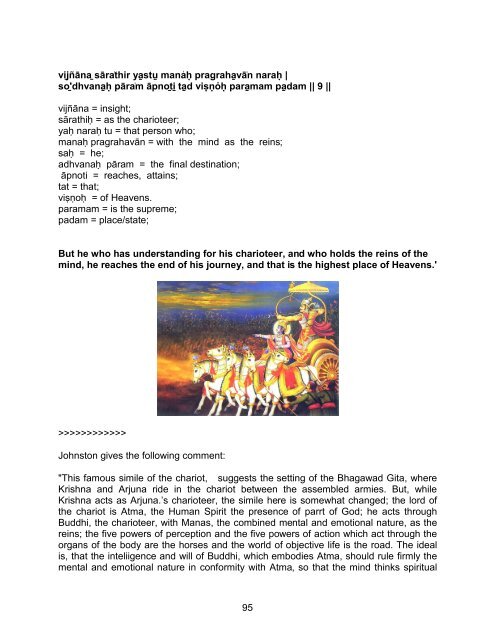KathaUpanishad
Create successful ePaper yourself
Turn your PDF publications into a flip-book with our unique Google optimized e-Paper software.
vi̱jñāna̱ sāra̍thir ya̱ stu̱ mana̍ ḥ pragraha̱ vā̍n naraḥ |<br />
so̱'dhvana̱ ḥ pāra̍m āpnoṯi̱ ta̱ d viṣṇo̎ ḥ para̱ mam pa̱ dam || 9 ||<br />
vijñāna = insight;<br />
sārathiḥ = as the charioteer;<br />
yaḥ naraḥ tu = that person who;<br />
manaḥ pragrahavān = with the mind as the reins;<br />
saḥ = he;<br />
adhvanaḥ pāram = the final destination;<br />
āpnoti = reaches, attains;<br />
tat = that;<br />
viṣṇoḥ = of Heavens.<br />
paramam = is the supreme;<br />
padam = place/state;<br />
But he who has understanding for his charioteer, and who holds the reins of the<br />
mind, he reaches the end of his journey, and that is the highest place of Heavens.'<br />
>>>>>>>>>>>><br />
Johnston gives the following comment:<br />
"This famous simile of the chariot, suggests the setting of the Bhagawad Gita, where<br />
Krishna and Arjuna ride in the chariot between the assembled armies. But, while<br />
Krishna acts as Arjuna.’s charioteer, the simile here is somewhat changed; the lord of<br />
the chariot is Atma, the Human Spirit the presence of parrt of God; he acts through<br />
Buddhi, the charioteer, with Manas, the combined mental and emotional nature, as the<br />
reins; the five powers of perception and the five powers of action which act through the<br />
organs of the body are the horses and the world of objective life is the road. The ideal<br />
is, that the inteliigence and will of Buddhi, which embodies Atma, should rule firmly the<br />
mental and emotional nature in conformity with Atma, so that the mind thinks spiritual<br />
95


















